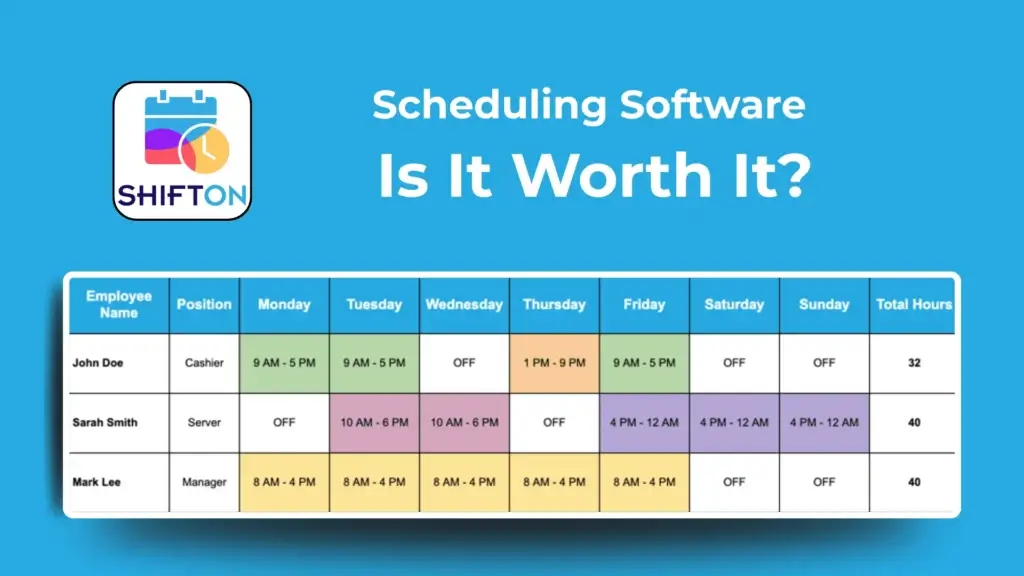Basic scheduling solutions, including Microsoft Word and Excel, hardly keep the workflow steady. As many industries, including restaurant, health, retail, and outsourcing, moved into the digital age, hundreds of scheduling software products appeared which significantly simplified the process of roster creation.
Before we explore the possibilities of modern scheduling software, it's crucial to get familiar with types of work rosters.
What type of rosters can be made in an employee schedule maker
Naturally, most modern companies use a fixed work schedule type due to its simplicity: the same number of hours and days every week - for example, when a company operates Monday to Friday from 9 AM to 6 PM. It is utilised by pharmacies, small shops, customer services, government organisations. In some cases, employees can work overtime and receive additional pay.
Flexible
On paper, this appears to be an ideal way of workforce organisation: employees and employers agree on the number of hours and days which need to be fulfilled on a weekly basis. They can work 20–30 hours a week whenever they choose or during a specific time of the day. Things get tricky when most employees want a flexible schedule. If this wasn't challenging enough to handle, there are a few flexible schedule subtypes:
Compressed workweek. This variation of a flexible schedule condenses a 40-hour week into a few days. For example, an employee could have three 12-hour or four 10-hour workdays but get an additional day off or two.
Flex. If employees select this option, they can choose the time when their shift begins and ends, but will need to work the same number of hours every day.
Result Oriented Work Environment. It doesn't require any working hours to count towards the salary, but instead, payments are based on the amount of work completed: deadlines met and tasks finished.
Split shift. This type of flexible roster allows dividing the shift between different times of the day. A worker can do 3 hours in the morning, 4 hours in the evening.
- Rotating
The less commonly used, but nevertheless alive and well schedule type is the rotating roster. If a business adopts a rotating schedule, it can operate 24/7 by breaking the cycle of production into three shifts: day, swing and night. This type of employee scheduling is mainly found in construction work, hospitals, power stations, and road work.
Employee shifts change weekly or quarterly, depending on work needs. For instance, those employed in construction jobs may work the night shift for one week and switch to a day shift the next. Employees might find these hard to manage, as their sleeping and eating patterns have to constantly adjust.
Why switch to an employee schedule maker
These roster types can seem a bit hard to manage, but fortunately, there's an array of employee schedule generators. They offer various features that make scheduling easy for different types of businesses, no matter what they choose for all of their workers or for a group of them.
This is made possible thanks to the various settings this software offers:
- Schedule generationUsers can generate rosters, no matter what type they select to work with. Most online scheduling software offers the creation of any number of shift templates and rosters.
- Shift managingIf there are changes to a shift's duration, they can be modified on the go. For example, if an employee wants to work more hours, but fewer days, some of their shifts can be removed, while others are extended or shortened for a selected period. Shifts that are not assigned to any employees can be deleted or claimed by other workers.
- Shift swappingIf any unexpected circumstances arise, employees can easily swap shifts with one another, to avoid unnecessary time-wasting on exchanging shifts using third-party software and to keep the workflow in check. There can be numerous situations where this feature will be beneficial. With that said, management does need to confirm these requests to maintain some level of control over workforce organisation.
- Time-off requestsFinally, most modern employee scheduling solutions provide a way for employees to request time off. Perhaps they are too tired, need a holiday, or will not be clocking in tomorrow due to illness. This can be done without using any third-party service. In some instances, users can attach documents to verify that their absence is justified by solid evidence.
There is a wealth of similar software products currently available on the market. They boast various aforementioned features and some of their own. With that said, we highly recommend the Shifton scheduling service. It provides company owners with a quick way of creating and deploying work schedules for any number of employees with various features available and a flexible schedule generation system.
The Shifton service is one of the employee scheduling software products currently available on the market.

 English (US)
English (US)  English (GB)
English (GB)  English (CA)
English (CA)  English (AU)
English (AU)  English (NZ)
English (NZ)  English (ZA)
English (ZA)  Español (ES)
Español (ES)  Español (MX)
Español (MX)  Español (AR)
Español (AR)  Português (BR)
Português (BR)  Português (PT)
Português (PT)  Deutsch (DE)
Deutsch (DE)  Deutsch (AT)
Deutsch (AT)  Français (FR)
Français (FR)  Français (BE)
Français (BE)  Français (CA)
Français (CA)  Italiano
Italiano  日本語
日本語  中文
中文  हिन्दी
हिन्दी  עברית
עברית  العربية
العربية  한국어
한국어  Nederlands
Nederlands  Polski
Polski  Türkçe
Türkçe  Українська
Українська  Русский
Русский  Magyar
Magyar  Română
Română  Čeština
Čeština  Български
Български  Ελληνικά
Ελληνικά  Svenska
Svenska  Dansk
Dansk  Norsk
Norsk  Suomi
Suomi  Bahasa
Bahasa  Tiếng Việt
Tiếng Việt  Tagalog
Tagalog  ไทย
ไทย  Latviešu
Latviešu  Lietuvių
Lietuvių  Eesti
Eesti  Slovenčina
Slovenčina  Slovenščina
Slovenščina  Hrvatski
Hrvatski  Македонски
Македонски  Қазақ
Қазақ  Azərbaycan
Azərbaycan  বাংলা
বাংলা 

